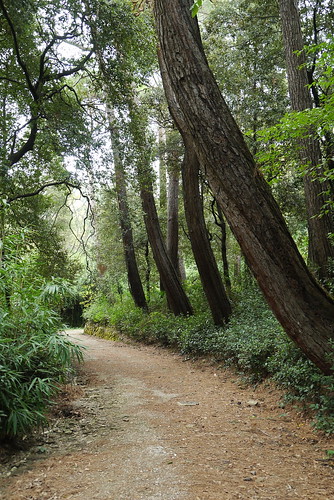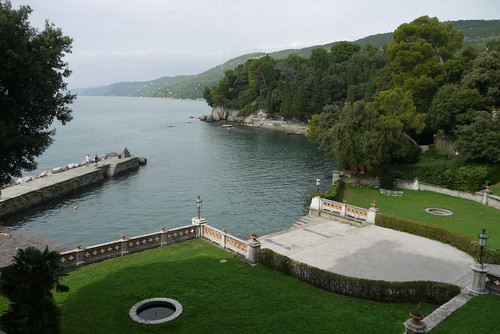Miramare Park, which at one time had no vegetation, and has now a surface area of 22 hectares (54 acres), stands on a rocky promontory overlooking the Adriatic Sea. The site was planned and arranged by Carl Junker, according to the wishes of Archduke Maximilian who carefully followed the building of his residence. As far as the botanical aspect was concerned, a gardener, Josef Laube, was called in but was replaced in 1859 by Anton Jelinek, a Bohemian who had taken part in the frigate Novara’s expedition around the world.
The park, on which work began in 1856, represents a classic example of a mixed, artificial implantation of ligneous forest-trees and bushes and it succeeds in blending the charm of a typically Northern environment and a Mediterranean context. In contrast to the baroque garden, the English one – on which Miramare is modelled – introduces a new relationship with nature, resulting from a different sensibility towards the material world. This is why, when strolling along the paths in the park, you can breathe in an atmosphere that is tightly bound up with the life of its owner and his romantic relationship with nature, which was typical of his epoch.
Before 1856, the park area was bare, with only some shrubs and thorny bushes. Today, on the other hand, there is a group of different species of trees that are, for the most part, of non-European origin or in any case, that are not native to the area. Within a period of ten years, cedars of Lebanon, North Africa and the Himalayas were planted, along with firs and spruces from Spain, cypresses from California and Mexico, various species of pine fromAsia and America, to which some exotic specimens, such as the giant sequoia and theginkgo biloba, were added. Miramare was conceived as a private garden and not as a park. In fact it does not have a monumental entrance or a driveway up to the castle. It was a garden of wonders, not intended for public use, even though the archduke opened it to the public a few days per week. Watercourses, pools, twisting paths, trees placed according to natural models, some grassy areas, are typical of English gardens. The roughness of the ground favoured the irregular lay-out of the promontory, combining the artificial transformation with the natural environment.
The park is also characterised by the presence of some buildings included in Junker’s project: the Castelletto – inhabited off and on by Maximilian and Charlotte – on which work began at the same time as work on the castle; the greenhouses, intended for the growing of the plants to be placed in the park; the ruins of the chapel dedicated to Saint Canciano, in whose apse is preserved a cross made from the wood of the frigate Novara, which was laid up in 1899; and lastly a little house, used nowadays as a coffee-shop, the “Swiss house“, placed at the edge of the swans’ lake.
Up until 1954, Miramare became the headquarters for German, New Zealand, British and American forces of occupation respectively. Finally in 1955, the complex was reopened to the public under the name Miramare Park, whose management was entrusted to the Sopraintendenza per i Beni Architettonici ed il Paesaggio e per il Patrimonio Storico, Artistico ed Etnoantropologico of the Friuli-Venezia Giulia region.
Today the gardens play host during the summer season to spectacles such as the musical “Sissi“, reliving the story of the Empire in its natural setting, and various concerts.
We have been to Trieste where we spent a week in our delightful villa, a veritable jewel in this southern clime, and facing one of the most beautiful gulfs in the world. It is impossible to imagine so thoroughly blue a sea in the North. When I first discovered it, I was overcome by an indescribable enthusiasm.
Charlotte of Belgium. 1857*
*From Castle Miramare historical and museum park by Rossella Fabiani














I love wild,untamed nature best. On the farm I had a secret garden that I would not permit to be cut or trimmed. It was a little slice of paradise.
I think there is a place for both a wild untamed garden and a formal park. I enjoy both
The park, on which work began in 1856, represents a classic example of a mixed, artificial implantation of ligneous forest-trees and bushes and it succeeds in blending the charm of a typically Northern environment and a Mediterranean context.
Better than a barren expanse.
I agree it must have looked rather bleak before the park and gardens were developed there.
They should have painted that bridge red and planted more water lilies in the pond.
Yes, just like the Monet’s garden.
I see the Monet similarities